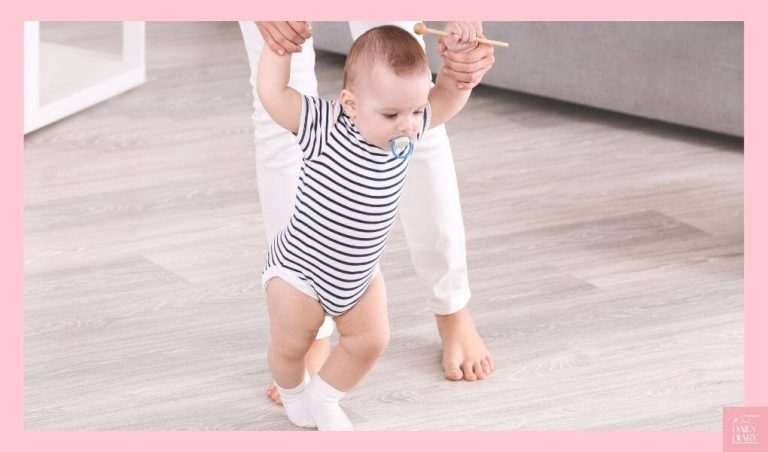Mastering The Art Of Swaddling: A Step-By-Step Guide For Parents
Congratulations on your new bundle of joy! As a new parent, you may feel overwhelmed with all the information and advice out there.
One practice that has been around for centuries and is still highly recommended today is swaddling. Swaddling involves wrapping your baby snugly in a blanket to help them feel secure and comfortable.
Note: This post may contain affiliate links, which means if you buy from my link I might make a small commission. This does not affect the price you pay. See the full affiliate disclosure here.
Swaddling can provide numerous benefits for both you and your baby, including better sleep patterns, reduced risk of Sudden Infant Death Syndrome (SIDS), decreased crying, and improved bonding between you and your little one.
However, swaddling can be tricky to master at first. In this article, we will guide you through step-by-step instructions on how to properly swaddle your baby, as well as some common mistakes to avoid so that you can confidently master the art of swaddling.

Understanding the Benefits of Swaddling
If you’re a new parent, you might be wondering why swaddling is such a big deal and how it can benefit your baby. Swaddling is the practice of wrapping your baby snugly in a blanket or cloth to create a womb-like environment that can help them feel secure and calm. This technique has been used for centuries and has been shown to have numerous benefits for both babies and parents.
One of the main benefits of swaddling is that it helps babies sleep better. When they’re wrapped up tight, they’re less likely to startle themselves awake with their own movements.
In addition, swaddled babies tend to stay asleep longer because they feel more comfortable and secure.
Swaddling also helps regulate your baby’s body temperature, which can help prevent overheating or getting too cold. However, it’s important to use proper swaddling techniques and follow safety guidelines to ensure that your baby stays safe while sleeping.
Choosing the Right Swaddle
Picking the perfect swaddle can make all the difference in ensuring your baby stays snug and secure for a good night’s sleep. When it comes to choosing the right swaddle, consider these four factors:
- Swaddle materials: Choose a material that’s soft and breathable, like cotton or muslin, to prevent overheating and ensure comfort.
- Swaddle sizes: Make sure you choose a swaddle that fits your baby snugly but isn’t too tight. It should allow room for movement of the legs and hips to prevent hip dysplasia.
- Ease of use: Look for a swaddle with easy-to-use closures or zippers for quick diaper changes.
- Durability: Invest in a quality swaddle that can withstand multiple washes without losing its shape or becoming worn out.
Taking these factors into consideration will help you find the perfect swaddle to keep your little one cozy and comfortable throughout their sleep.
Remember, every baby is different, so don’t be afraid to try out different types of swaddles until you find one that works best for your little bundle of joy!
In conclusion, choosing the right swaddle is essential to ensuring your baby’s safety and comfort during sleep time. Keep in mind the materials used, size, ease of use, and durability when selecting a swaddle for your little one. With careful consideration and trial-and-error experimentation if necessary, you’ll be able to find just the right fit so both you and baby can rest easy at night!

Step-by-Step Guide to Swaddling
Let’s dive into the easy-to-follow, step-by-step process of wrapping your little one up tight in a cozy swaddle! Swaddling techniques have been used for centuries to help calm fussy babies and promote better sleep. By creating a snug cocoon around your baby, you can mimic the feeling of being in the womb and provide them with a sense of comfort and security.
To start, lay out a flat surface like a changing table or bed and gather your swaddle blanket. Place the blanket on the surface in a diamond shape with one corner pointing towards you. Fold down the top corner about six inches to create a straight edge, then place your baby on their back with their shoulders just above this edge.
Take their left arm and gently tuck it against their body, then bring the bottom corner of the blanket over their arm and chest, tucking it under their right side. Next, take the right arm and repeat this process by tucking it against their body before bringing the remaining corner of the blanket across their chest and securing it under their left side. Your baby should now be wrapped up tightly but comfortably in their swaddle!
| Step | Description |
|---|---|
| 1 | Lay out swaddle blanket in diamond shape |
| 2 | Fold down top corner to create straight edge |
| 3 | Place baby on back with shoulders above straight edge |
| 4 | Tuck left arm against body; bring bottom corner over arm/chest & tuck under right side |
| 5 | Tuck right arm against body; bring remaining corner across chest & secure under left side |
Remember that every baby is different when it comes to what makes them feel comfortable – some may prefer a looser swaddle while others need to be wrapped more tightly. Pay attention to your little one’s cues as you’re wrapping them up so you can adjust as needed for optimal comfort. With a little practice, you’ll soon become a pro at swaddling and be able to provide your baby with the cozy snuggles they crave.
Common Mistakes to Avoid
When it comes to swaddling your baby, there are a few common mistakes that you should avoid.
First, be careful not to over-swaddle your little one as this can increase the risk of overheating and restrict their movement.
Secondly, make sure you position them correctly, with their hips slightly flexed and their arms at their sides, to prevent any hip-related issues.
Lastly, avoid overheating by using lightweight fabrics and checking your baby’s temperature regularly.
By keeping these key points in mind, you can ensure a safe and comfortable swaddling experience for your newborn.
Over Swaddling
You don’t want to wrap your baby too tightly and risk over swaddling, which can be uncomfortable or even dangerous for them. Over swaddling happens when you wrap your baby so tightly that they cannot move their limbs at all. This can lead to hip dysplasia, a condition where the hip joint is not formed properly, or even suffocation if the fabric covers their nose and mouth.
While swaddling has its pros and cons, it’s important to know when to stop. Most babies will outgrow the need for swaddling by 2-3 months old as they start to roll over on their own. If your baby seems restless or fussy while being swaddled, it’s time to stop as they may be telling you that they are ready to have more freedom of movement.
Always remember that every baby is different and what works for one might not work for another, so pay attention to your baby’s cues and adjust accordingly.

Incorrect Positioning
You’ve learned about the dangers of over swaddling, but another common mistake parents make is incorrect positioning. It’s important to ensure that your baby is in the correct position before wrapping them up snugly.
The correct positioning involves placing your baby on their back with their head facing up and making sure they are not slouching or hunched over. This ensures that your baby’s airway remains open and unobstructed while they sleep. Additionally, proper wrapping technique is crucial for ensuring your baby stays safely swaddled throughout the night. Remember to never wrap too tightly around your baby’s hips or legs as this can cause hip dysplasia.
With these tips in mind, you’ll be well on your way to mastering the art of swaddling and ensuring a safe and comfortable sleeping environment for your little one.
Here are three key points to remember when it comes to correct positioning:
- Always place your baby on their back with their head facing up.
- Make sure they are not slouching or hunched over.
- Ensure that their airway remains open and unobstructed.
Remember, babies have delicate bodies and require gentle handling. Taking care to properly position and wrap them will help keep them safe while also providing a sense of comfort during sleep time. Don’t forget- practice makes perfect!
Overheating
Let’s explore the importance of avoiding overheating when swaddling your little one. While swaddling provides comfort and security for babies, it’s important to keep in mind that overheating can lead to serious health risks such as Sudden Infant Death Syndrome (SIDS). As a parent, it’s essential to monitor your baby’s temperature while they’re being swaddled.
Preventing overheating is simple and easy to do. Here are some signs of overheating during swaddling that you should be aware of:
| Excessive sweating |
|---|
| Rapid breathing |
| Flushed skin |
| Restlessness |
| Irritability |
By keeping these signs in mind, you can take necessary steps to prevent your baby from getting too hot while being swaddled. Remember, safety should always come first when it comes to taking care of your precious little one.
Tips for Successful Swaddling
To ensure your baby feels snug and secure, it’s important to follow these helpful tips when swaddling.
First, choose the right type of swaddle blanket for your baby. There are various options available in the market, from muslin to cotton to fleece. Choose one that is lightweight and breathable to prevent overheating. For premature babies, special swaddle blankets may be needed to provide a more delicate and comfortable wrap.
Secondly, make sure you know how to properly swaddle your baby. Here are some tips:
- Lay the blanket flat on a surface with one corner folded down.
- Place your baby on the blanket with their shoulders just above the folded corner.
- Straighten their left arm and wrap the left side of the blanket over their body and tuck it under their back.
- Fold or twist the bottom end of the blanket loosely and tuck it behind them.
- Bring the right side of the blanket over their body and tuck it tightly under their left arm.
- Finally, fold or twist any remaining fabric loosely around them.
Swaddling can help soothe a fussy baby by mimicking the warm coziness they felt in utero. By following these simple tips, you’ll be able to master this art in no time!
Conclusion
Congratulations! You’ve now mastered the art of swaddling. By understanding the benefits of swaddling, choosing the right swaddle, and following our step-by-step guide, you can ensure that your baby feels safe and secure while sleeping.
Remember to avoid common mistakes such as wrapping too tightly or using a swaddle too small for your baby. Additionally, try different swaddle techniques and find what works best for you and your little one. Don’t be afraid to ask for help from healthcare providers or other experienced parents if needed.
Swaddling is an ancient practice that has been used for centuries to soothe babies. When done correctly, it can benefit both babies and parents by promoting better sleep patterns and reducing fussiness.
We hope this guide has provided you with valuable information on how to successfully swaddle your newborn. Happy parenting!






